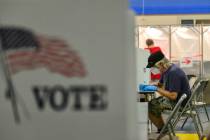Fed up with politics
Nearly 60 percent of Americans think we need a viable third party in our political system, according to a new survey from Gallup.
And who can blame them?
This is 2016, the year in which the two least-popular candidates in each major party earned the nomination, either through bluster and braggadocio or by careful planning and organization. And Americans don’t like their choices.
It wasn’t always this way: In 2008, Gallup reported that just 47 percent thought we needed a third party, while 47 percent said the two major parties adequately represented the views of the American people. In 2012, 46 percent said yes, while 45 percent said no.
But that was before Donald Trump and Hillary Clinton, before rapists, drug dealers and murderers, before the basket of deplorables, before violence at political rallies and deleted emails and secret tax returns and hidden illnesses. That was before people on both sides were shaking their heads and asking each other: Out of 325 million Americans, this is the very best we can do? Really?
Today, 57 percent of Americans say the Republican and Democratic parties aren’t doing an adequate job of representing the views of the public, and that a third party is needed, Gallup found. Just 37 percent supported the current two-party system.
It’s probably not surprising: Gallup also found in May that just 44 percent of people had a favorable view of the Democratic Party, and only 36 percent had a favorable view of the Republican Party. Clinton’s favorability (as of Sept. 7) was 38 percent, according to Gallup. The pollster put Trump at 34 percent favorable.
There are third parties out there, especially the Libertarian Party, which this year has fielded a ticket of two ex-governors that’s the most mainstream in that party’s history. Former New Mexico Gov. Gary Johnson and former Massachusetts Gov. William Weld are even airing TV ads aimed at mainstream audiences. It would be better for Johnson if he knew where Aleppo was located, or could name his favorite foreign leader, but Johnson-Weld remain a viable option for conservatives.
This may also be the year that more people than ever learn of the Green Party. This year’s nominee — Dr. Jill Stein — is pitching herself as the inheritor of Bernie Sanders’ small-d democratic revolution. (By the way, for those who persist in thinking Clinton is a progressive, liberal or socialist, check out Stein’s website.)
Sadly, due to organizational missteps, Stein will not appear on Nevada’s ballot.
But one only-in-Nevada mainstay will be there when Nevadans start heading to the polls — None of These Candidates. With the current mood of the electorate, don’t be surprised if you see None gaining a larger share of the vote than it did in past presidential years such as 2008 (0.65 percent) or 2012 (0.57 percent).
Sadly, None can’t ever really win an election — even if None gets the most votes, the highest real-person vote-getter wins the balloting. As a result, some say None is a wasted vote, but that’s wrong: None is the perfect way for a voter to say: I’ve seen all the candidates, weighed them and found them wanting. Do better next time.
No matter what else, the existing parties shouldn’t ignore the Gallup results and the None percentage. These numbers represent a real and growing dissatisfaction with the way things are, and a real opportunity for someone to devise a way forward, not based on riding a wave of impotent and misdirected anger, or representing a triangulated status quo, but on harnessing honest frustration to gather a majority interested in making real progress.
If it takes a third party to do that, so be it.
Steve Sebelius is a Review-Journal political columnist. Follow him on Twitter (@SteveSebelius) or reach him at 702-387-5276 or SSebelius@reviewjournal.com.

















